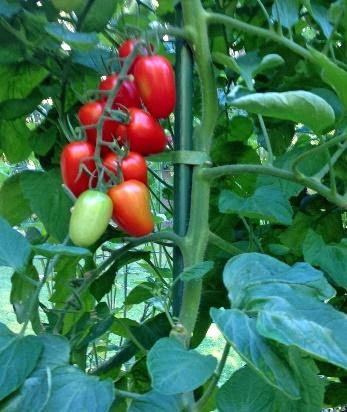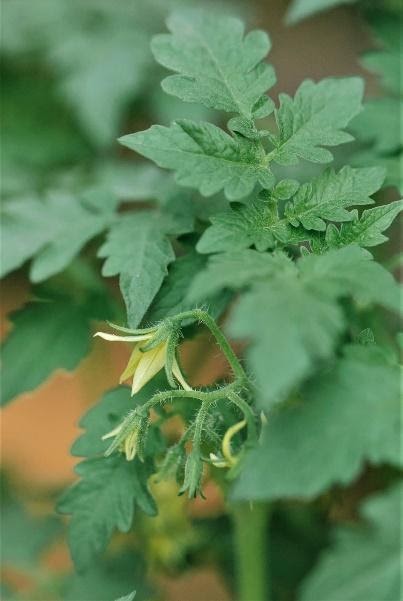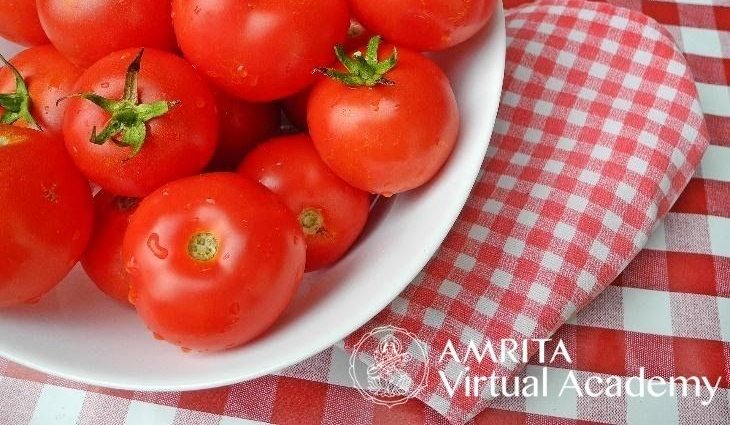
How To Grow Delicious Tomatoes, Part 2
Spacing
When planting tomatoes one of the first considerations is how far apart should I put my plants. Spacing will be determined by the plant variety you choose. The smaller ones can be planted closer together. Those that get pretty big need room to grow. If you are staking the plants, then you can bring them closer together. General guidelines are about eighteen inches to two feet apart in the rows and about three to five feet apart between rows. It really depends on the variety. If using raised beds that are not walked on, then you can reduce the spacing.

Seedlings, Hardening-off
Seedlings are really essential in almost all parts of the US, as the growing season is not long enough for the plants to fully develop. Seedlings should be started 6 to 8 weeks before you can place them outside. The temperature outside needs to be warm enough, as I stated earlier. When using seedlings it’s important to harden them off by gradually placing them outside and reducing their watering and fertilization and not allowing them to get exposed to cold temperatures in the evening. Covering or sheltering them in the night is very important, as you don’t want seedlings to be exposed to temperatures lower than 60°F. This way, they slowly adapt to the winds and hot sun of the outdoors. Once they have gone through about four or five days of this adaptation, then go ahead and plant them.
If the soil is not warm enough, then place black plastic on the bed to warm it up during the time you are hardening off the tomatoes.
Transplants have been grown in 70° weather. Therefore, putting them in temperatures that are much colder than this is not a good idea, as they tend to develop catfacing (indentations and scars around the blossom end of the fruit versus the stem end. These scars can develop deep inside the fruit. It allows for disease and animals to move in and makes the fruit look really ugly.) Therefore, keep the plants above the temperature in which they are normally grown or very close to it, especially at night, by providing protection until the temperatures outside get into the 70°s F.
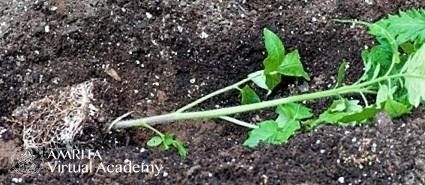
Transplanting and Liming Tomatoes
Tomato plants are one of the only plants where you should plant deeper than the soil (3) line in which the seedlings are grown. The transplant should be less than a foot tall. You can dig a trench about four to six inches deep and carefully bend the stem of the plant so the root is at an angle and the actual stem is partially planted, allowing only two or three sets of its true leaves above the soil. The stem will develop roots and establish itself and make the plant stronger.
Before you plant, add about a ¼ cup of lime to the soil where the tomato plants will go. Incorporating this additional lime will help prevent blossom end rot. Use powdered lime, as lime takes time to dissolve and incorporate into the soil. The powdered version will dissolve quicker than the pelletized version. Do this for each plant hole or area right before planting.
Water well once you have finished planting and immediately place the cage or stake into the ground. The stake should be around six foot tall, and placed no more than a foot away from the plant. Do a small application of organic fertilizer or compost tea. Do not over fertilize.
Watering
Regular watering is a must with tomatoes. A good inch or two per week is acceptable, depending on the type of soil. If it’s sandy, then two inches of water is good, during the hot summer days and if it’s a more clay type, then one inch will suffice. The main thing is to keep it evenly moist and not to allow it to dry out. Mulching with straw, partial compost, or shredded leaves is really key, as this will prevent the roots from drying out. Tomato roots are near the surface and can easily be impacted by drought, after which they would immediately begin to develop blossom end rot.
During the hot summer months, it is best to water deeply twice a week or between one to two inches per week in two separate intervals.
Why Do Huge Plants Bear No Fruit or Very little?
The main reason for this is over fertilization. Once the plants are planted in good organic soil and lightly fertilized, it is best to not fertilize again until the plant starts flowering. The reason is that, in the beginning, the plant is in the growth phase. If you fertilize early on, then it stays in this phase. You will get a huge plant but no fruit. Therefore, wait until you see flowering and then give it a side dressing. This makes sure that the plant has moved into a reproductive stage.
Disease and Insects

Blossoom End Rot
This is damage to tomatoes in the blossom end of the fruit. The fruit forms a tan or flat black spot, and then secondary bacteria or fungi enter and cause further damage. Usually, this occurs in hot dry spells.
The cause is a lack of calcium as the fruit develops. This doesn’t mean there is no calcium in the soil but rather it is not available to the plant. Some causes of this are uneven watering; as a result of water fluctuation, the calcium becomes less available to the plants. Excessive fertilization causes the plant to go into a fast growth spur, especially if using non-organic fertilizers that are heavy on salts. Weeding done too close to the plants can damage too many surface roots, and this will stress the plant and not allow it to take up as much water.
The best solution is keeping the moisture even, mulching, avoiding weeding with a hoe or tool at least a foot from the plant, but rather hand weeding.
Growth cracks – the fruit grows very quickly and literary cracks open.
This occurs if you get heavy rains and hot temperatures or if, after having gone through a drought period, all of a sudden you get a lot of water and the growth occurs very rapidly. The cracks are not a problem, as the fruit forms a film and quickly heals itself. The problem is that sometimes bacteria and fungi attack the fruit and cause it to rot.
Click here to learn more about our gardening courses inspired by Amma!
It is best to keep the plant evenly watered, to use mulch, and to use varieties that are less susceptible to cracking. Some good hybrids have been produced.
When using mulch, use straw or any of the others mentioned earlier. If using dried grass clippings, make sure they are not treated in any way with any type of chemicals. Tomatoes are very susceptible to chemicals used on lawns. If plants are exposed, they will grow distorted, or they can twist or just get stunted.
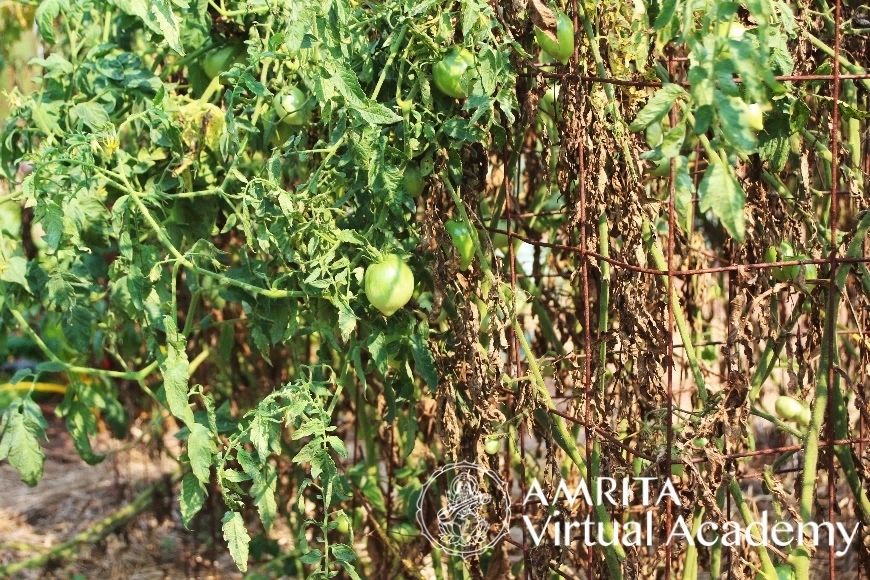
Fusarium wilt, Verticillium wilt, Early blight and Tobacco mosaic virus.
These diseases cause the plant to suddenly wilt and die quickly. They may look different but the result is early death. I feel that, if you grow resistant varieties, it’s the best thing. But if you do grow some heirlooms, there are some varieties that are more susceptible than others, and this is the chance you take.
Keeping the garden free of debris by, cleaning up old plants from the prior year, using a three-year crop rotation, not smoking in the garden and washing your hands after smoking before touching the plants, and disposing of any plants that get infected – versus composting them. The disease resistant varieties are labelled when grown and for the seeds sold.

Pruning of Tomatoes
Intermediate and indeterminate tomatoes are the ones that need pruning due to the vast amount of suckers they send out. The suckers can be from the base of the plant or in between the main stem and the leaves. These suckers develop into full-fledged plants that bloom and produce tomatoes. So why prune them at all?
Many studies have been made to determine the value of pruning. The results are very consistent in showing that pruning will increase your yield, as the tomato plants tend to send so many suckers. These suckers take up a lot of the plant energy by producing lots of leaves and a whole new plant. Therefore, less energy is going into fruit production; instead, it’s all going into making leaves. So, if all the energy is going to produce leaves, there will be less fruit. So many leaves increase the potential for disease due to decrease in circulation and aeration.
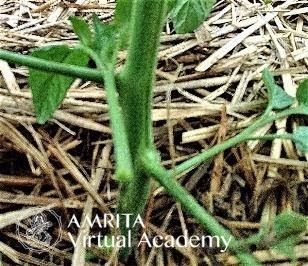
But the pruning has to be done right versus just any old way. Otherwise, the yields will be less. Many people think it’s the top that gets pruned, and the tips. This is not the case at all. When you see suckers coming up from the roots or the base of the soil, prune these away. There is one sucker that does not get pruned. You must look for the first flowers to appear.
Once this flower appears, there will be one sucker right below it, no exceptions. This particular sucker does not get pruned. All other suckers between the main stem and the leaf get removed at the junction, except that one right below the first flower.
Why don’t we prune away the one sucker right below the first flower? There have been several studies that found the additional growth hormones that come into play as the plant goes from a growing stage to a fruiting stage are found in great numbers right by the first flower. As a result, they positively influence this sucker, resulting in a very large productive plant that produces lots of fruits. The yield is just as high as the main plant. Proportionally, the fruit ratio is higher than the leaf ratio. Unlike the rest of the suckers, which produce a lot of leaves and less fruit by comparison.
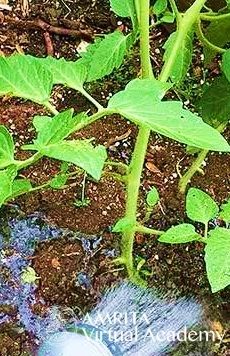
If you observe closely, you will notice that the suckers below this particular first flower – sucker you are leaving behind will be larger than those below it. Despite the fact the other suckers lower in the plant are older and came out maybe a week or two before.
You will then remove all the other suckers growing between the stem and the leaves. You will also remove any suckers from the one sucker that you have allowed to develop, as all suckers behave in the same way as a regular plant. The end result is a two-plant system developing with one root stock. When you stake the main plant, also have a second stake for the extra plant you will allow to develop.
Happy growing!
All photos are copyright protected. Photos 1-4 by Patricia. Photos 5-8 by Marleny.





